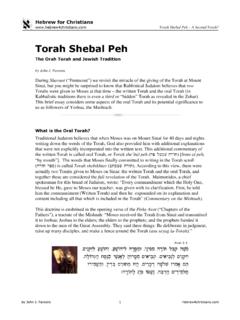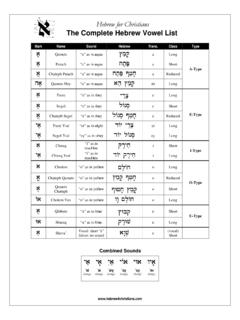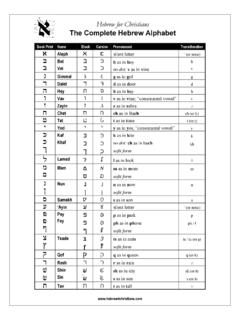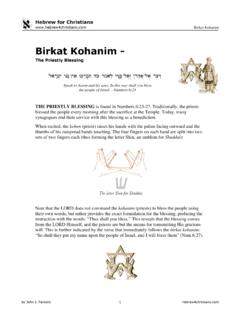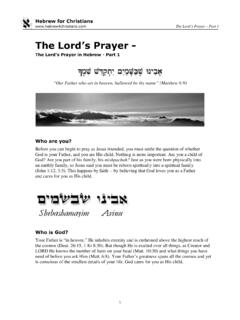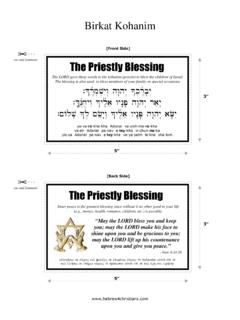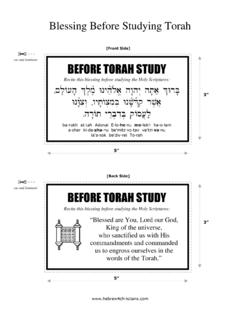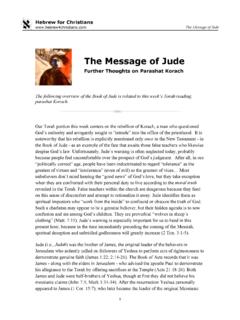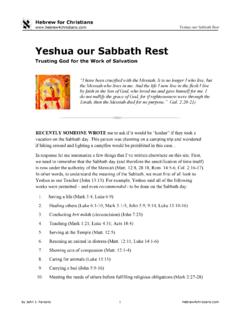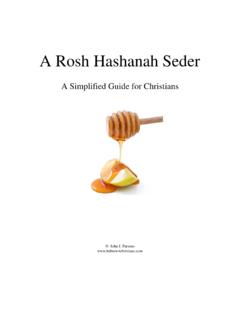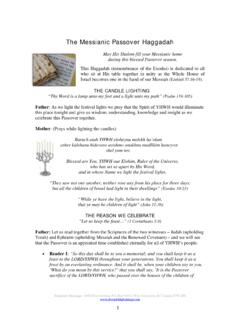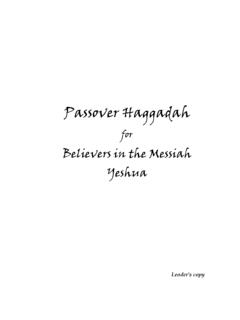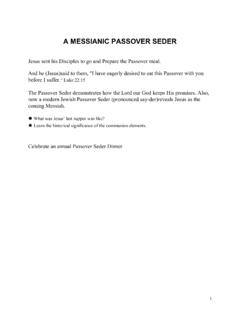Transcription of Worthy is the Lamb - hebrew4christians.com
1 Worthy is the Lamb A Messianic Passover haggadah John J. Parsons Worthy is the Lamb A Messianic Passover haggadah John J. Parsons Copyright 2004-2018 All rights reserved. Rev. 14; First Edition 2004 You may use this haggadah for your own personal Passover Seder, though you are not permitted to modify or re-purpose it in any way, nor are you permitted to republish it in any manner without the express written consent of the author. ISBN Number 978-9780967970 Hebrew for Christians PO Box 27061 Golden Valley, Minnesota 55427-0061 This work is gratefully dedicated to Yeshua the Messiah, the great Lamb of God who takes away the sins of the world. May His great Name be exalted forever and ever! rv,[w> z[o tx;q;l' x;WbJ'h; hF,l; hw"an" hk'r" rd"h'w> dAhw> hr"Wbg>W hm' 'w> Revelation 5:12 xsph hfHebrew for Christians i Worthy is the Contents: Introduction to Passover.]]
2 1 Welcome to the Seder .. 4 The Passover Seder Plate .. 5 The Steps of the Passover Seder .. 6 Nerot Lighting the Candles .. 7 Partaking of Miriam s 10 Kadesh The First Cup .. 12 Urchatz Ceremonial Hand Washing .. 16 Karpas Dipping the Vegetables .. 17 Yachatz Breaking the Matzah .. 18 Maggid Telling the Passover 20 Rachtzah Netilat Yadayim .. 38 Motzi Matzah Eating the 39 Maror Eating the Bitter Herbs .. 43 Korekh Eating the Hillel 44 Shulchan Orekh Eating the 45 Tzafun Eating the Afikoman .. 46 Barekh Blessing after the meal .. 48 Hallel Offering Praise .. 50 Nirtzah Conclusion of the Seder .. 54 Hebrew for Christians 1 A Passover Introduction to Passover The holiday of Passover, or Pesach (xs;P,), begins during the full moon in the first month of the year, namely on the 14th day of Nisan.
3 Passover is called the feast of freedom since it celebrates the deliverance of the Israelites from bondage in Egypt and memorializes the night when the faithful were protected by the blood of the lamb - a clear picture of the sacrifice of Yeshua the Messiah as Seh HaElohim - the Lamb of God who takes away the sins of the world (John 1:29). The Book of Exodus recounts how the LORD sent Moses to Pharaoh to serve as the deliverer of Israel. The Pharaoh, of course, refused Moses appeal to set the Israelites free from their slavery, and the stage was then set for the showdown between the God of Israel and the so-called gods of Egypt. The final terrible plague that would descend upon the people of Egypt would be the death of the firstborn in the land. Only those families that sacrificed an unblemished male lamb and smeared its blood upon the doorposts of the house would be passed over (pasach) from the impending wrath from heaven.
4 God commanded that a few days before the Passover, each head of household should set aside a young male lamb to be examined for blemishes and to ensure its fitness as an offering. The Torah refers to this as the Lamb of God, as if there was only one: You shall keep it [ , the Passover lamb] until the fourteenth day of this month, when the whole assembly of the congregation of Israel shall slaughter him (A tao) at twilight (Exod. 12:6). During the afternoon of the 14th, the lamb was slaughtered and its blood smeared on all three sides of the doorframe, top, right and left, that is, in the form of the Hebrew letter Chet (x). This letter, signifying the number 8, is connected with the word chai (yx), short for chayim (~yyx), meaning life. Some say that the letters of the Divine Name YHVH (h w h y) were also daubed on the doorposts: The Yod (y) on the top beam, the Vav (w) on the right, and the Hey (h) on the left.
5 That night ( , Nisan 15th) the meat of the Passover was to be roasted and eaten with unleavened bread ( , matzah) and bitter herbs. The meal was to be eaten in haste, since the Jews were to be ready to begin their journey immediately after God smote the firstborn. God passed over those homes whose doorposts were marked with the blood of the Passover lamb. God further commanded that Passover should be commemorated annually as a reminder of the deliverance from Egypt. Only unleavened bread is to be eaten for seven days, and the first and seventh days of Passover are to be days of holy assembly on which all work is forbidden. The Passover Seder (service) occurs on Erev Pesach, the evening of Nisan 14th, which then becomes Nisan 15th during the Seder ceremony at sundown. This agrees with the commandment given in the Torah, In the first month, from the fourteenth day of the month at evening, you shall eat unleavened bread until the twenty-first day of the month at evening (Exod.)
6 12:18). Hebrew for Christians 2 Worthy is the The Importance of Passover All of the Biblical holidays begin with the holiday of Passover. On the first day of Nisan, two weeks before the Exodus, God showed Moses the new moon and commenced the divine calendar (Exod. 12:2). Two weeks later, the Israelites kept the Passover by daubing the blood of the lamb on their doorposts. At the stroke of midnight on Nisan 15 God sent the last of the ten plagues on the Egyptians, killing all their firstborn. On the 6th of Sivan, exactly seven weeks after the Exodus (49 days), Moses first ascended Sinai to receive the Torah (Shavuot). Forty days later, on the 17th of Tammuz, the tablets were broken. Moses then interceded for Israel for another forty days until he was called back up to Sinai on Elul 1 and received the revelation of the Name (h w h y).
7 After this, he was given the second tablets and returned to the camp on Tishri 10, which later was called Yom Kippur, the Day of Atonement. In Jewish tradition, Passover has four distinct names: Chag Ha-Aviv The Festival of Spring (Deut. 16:1) Chag Ha-Matzot The Festival of Matzah (Exod. 12:17-20) Chag Ha-Pesach The Festival of the Pascal Lamb (Num. 9:2) Z man Cheruteinu The Festival of Freedom The Exodus from Egypt is undoubtedly one of the most fundamental events of the Jewish people. In addition to being commemorated every year during Passover (Exod. 12:24-27; Num. 9:2-3; Deut. 16:1), it is explicitly mentioned in the very first of the Ten Commandments (Exod. 20:2), and it is recalled every Sabbath day (Deut. 5:12-15). The festivals of Shavuot and Sukkot likewise derive from it, the former recalling the giving of the Torah at Sinai and the latter recalling God s care as the Exodus generation journeyed from Egypt to the Promised Indeed, nearly every commandment of the Torah (including the laws of the Tabernacle and the sacrificial system) may be traced back to the story of the Exodus.
8 Most importantly, the Exodus prefigures and exemplifies the work of redemption given through the Messiah as the great Lamb of God. The very first occurrence of the word Torah in the Scriptures refers to the faith of Abraham (Gen. 26:5), and the second occurrence refers to the law of Passover: "There shall be one law for the native and for the stranger who sojourns among you" (Exod. 12:49). The Number Four The letter Dalet (d) means door. Besides the four names for Passover, there are four expressions of redemption, four cups of wine, four blessings, four foods on the seder plate, the four questions, etc. The Ten Plagues The ten plagues (eser ha-makkot) were intended to judge Egypt and its gods. A second chance for observing the holiday (on Iyar 15) was permitted for those who missed the Seder due to ritual impurity (Num.)
9 9:9-12). The Seder is called leil shimurim (~yrIMuvi l yle), a night to be guarded in the Torah begins with the Lamb slain in the garden (Gen. 3:21) and ends with the Wedding Feast of the Lamb (Rev. 19:7). Hebrew for Christians 3 Worthy is the Preparing for Passover During Passover no chametz (leavened products) may be eaten or found within your home for a full seven days. Preparing for Passover involves cleansing your house of all chametz, preparing a kosher meal for the guests, setting the Seder table with special Passover foods and dishes, reviewing the story of the Exodus by studying a haggadah (liturgy), and so on. The ceremonial search for chametz is customarily performed by candlelight on the night before the Passover Seder. A feather and a spoon are often used to sweep up the last crumbs of bread, which will then be burned with other chametz the following morning.
10 Here is the traditional blessing regarding the removal of chametz: Blessed are You, LORD our God, King of the universe, Who sanctifies us with His commandments and commanded us to remove chametz. Z man Cheruteinu Passover is called z man cheruteinu (W nteW rxe ! m'z>), the season of our freedom. Many people think freedom means being able to do what they want to do, when they want to do it, but that is not the Torah s idea of freedom. Yeshua told us whoever commits sin is the slave ( ) of sin, and went on to say if the Son sets you free, you will be free indeed (John 8:34-36). True freedom is therefore moral and spiritual rather than physical. Freedom has to do with the ability to choose what is right and good. In Hebrew, these two ideas of freedom are expressed using two different words.
